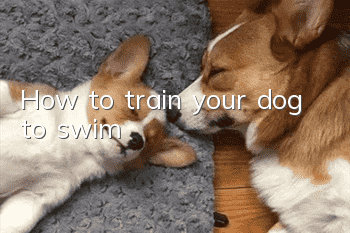How to train your dog to “swim”

Does a dog still need to learn to swim? Isn’t it born with it? Don’t think that dogs can swim when they are born. In fact, dogs, like humans, have to learn. Dog parents, teach your dogs to swim in the water and share the fun of swimming with your dogs this summer.
Suitable age: 8 months-0 months
Training goal: Let the dog learn to swim and share the fun of swimming with the dog owner.
Applicable dog breeds: all dog breeds
Equipment: collar | traction rope | dry towel | snacks
Level: Middle school (improvement)-Sports skills training
Training cycle: 10 minutes*10 times
Steps to train your dog to “swim”:
Step 1: When teaching a dog to swim, the size and age of the dog should be taken into consideration. If it is your first time to take your dog swimming, you should choose a good place. A private swimming pool is of course the best, and streams and rivers are also good. It is important to note that the practice area you choose must be clean and free of debris at the bottom, otherwise it will be unsafe for you and your dog. In addition, the shallow water is convenient for teaching.
Second step:Before letting the dog go into the water, the dog should be tied up on a leash. This can ensure safety and make it easier for parents to control the dog at any time in the water. When the dog encounters problems in the water, such as sinking, the dog can be rescued from danger in time through the rope chain.
Step Three: Use toys to lure the dog to practice in shallow water. When swimming for the first time, let it get used to activities in the water. You can gently splash water on the dog, but do not splash water on its face to prevent the dog from feeling uncomfortable. In the water, the owner can hold the toy and induce the dog to swim forward step by step, allowing it to slowly adapt. Most playful dogs will swim around happily following toys. When your dog is used to swimming in the water, you can take it to deep water.
Step 4: Praise a lot + get enough rest. If you encounter a dog that is not playful and the toy does not have the expected effect, the owner must be patient and constantly praise and encourage the dog to move forward in the water. When appropriate, let the dog take a break and drink some water to relax his mood. Be sure to remember: "Haste makes waste." Rushing for quick results may make your dog resent and fear water. Not to mention swimming, your dog may even hate daily bathing.
- Can dogs also suffer from hypoglycemia? What should I do if my pet dog has hypoglycemia?
- Puppy curled up sleeping
- How to care for a pregnant dog?
- What should I do if my Chihuahua eats too much and has diarrhea?
- Know the diseases that dogs are prone to in autumn, and stay away from them!
- How to treat and prevent canine distemper in dogs
- Morphological characteristics and training methods of Wolf Green Dog|Pictures|How much does one cost?
- How to trim Samoyed's feet?
- How to choose purebred Doberman Pinscher and what to pay attention to
- What's going on when your dog sneezes? What should I do if my dog sneezes?



